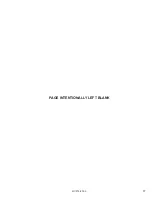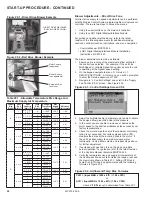
15
MCP15-500.9
For Condensing furnace types, as determined from Table 12.1
on page 12, during heating operation, condensate is produced
in the furnace sections. The installation requires condensate
drain systems from each furnace section, as shown in Figures
15.1 and 15.2 and described below. Condensate trap kits are
provided with the unit.
1. For proper heating system performance, the condensate
drain system must include a trap for each furnace.
B-Cabinet units have one furnace while C and D-Cabinet
units have two furnaces.
2. All joints must be watertight to prevent condensate
leakage. The drains must be extended down through the
base of the unit and into the heated space below.
3. Each heat exchanger drain assembly includes a threaded
elbow that is oriented down as shown in Figure 15.1. Once
the male threaded PVC adapters, included with the kit, are
glued to the PVC drain pipe (by others) that extends into
the space, they are to be routed up through the holes in
the unit base pan and screwed into the elbow connections.
The threads must be sealed to prevent leaks.
4. Unions are recommended to permit maintenance of the
drains and to facilitate service of the heater. A union is
shown on both sides of each trap.
5. A vacuum breaker is required after each trap. The vacuum
breaker should be constructed so that dirt and debris do
not enter and clog the drain system.
6. Local code permitting, multiple condensate drain systems
may be joined after the traps and connected to a sanitary
drain within the building. Because the condensate
produced is acidic, some municipalities may require that
the condensate be neutralized before being discharged into
the sanitary sewer. A condensate neutralizer tube kit is
available to reduce the pH. A single tube can be used for
drains that are joined after the traps providing the tube is
installed after the junction. Refer to the kit instructions in
the latest revision of Modine literature #75-561.
7. For proper operation, the traps must be primed with water.
The traps must be installed with the higher side connected
to the heater and the lower side connected to the drain.
8. If there is an opportunity that the temperature in the space
will fall below freezing during non-operating periods, the
condensate drain systems and secondary heat exchanger
must be completely drained to prevent damage.Alternately,
heat tape can be applied to the drain pipe system in
accordance with the heat tape manufacturers instructions.
9. When the furnace condensate drain system has been
installed, proceed to the “Start-Up” section.
Figure 15.1 - Furnace Condensate Drain and Float
Switch Location
j
To Drain Connection on Unit
3/4" PVC Male Threaded Adapter
(included with kit)
3/4" PVC Pipe with Sufficient Length to Reach
the Heat Exchanger Drain Connection on Unit
3/4" PVC Unions for Ease of Service
PVC "EZ-Trap" for Proper Drain Trapping
(included with kit)
Notes:
- Drain pipe from unit must enter the high side of trap.
- A 3/4" to 1" bushing by others may be required.
- The trap must be located in a heated space
or protected from freezing.
Vacuum Breaker Components
To Condensate Neutralizer
(optional) and/or Building
Drain System
NOTE:
Components not indicated as
“
included with kit
” are to be
supplied by others.
k
B-Cabinet units require a single drain system while C and D-Cabinet units
require two condensate drain systems, one for each furnace.
GAS HEATING OPTION CONDENSATE DRAIN AND TRAP INSTALLATION
Drain Connection
to Trap and Drain
in Heated Space
(each furnace)
Furnace Condensate
Drain System Float
Switch (each furnace)
j
D-Cabinet unit shown for example purposes. B and C-Cabinet condensing
furnace options will also have a condensate drain system float switch with a
drain connection through the base of the unit.
Figure 15.2 - Condensate Drain System with Trap
and Vacuum Breaker
k
THIS SECTION APPLIES TO UNITS WITH
OPTIONAL CONDENSING OR HYBRID
GAS HEAT (MODEL DIGIT 17=2 OR 3)
PER TABLE 12.1.
IF THE UNIT DOES NOT HAVE
CONDENSING GAS HEAT,
SKIP TO PAGE 16.
REVIEW BEFORE PROCEEDING
Furnace Condensate Drain/Trap Installation















































